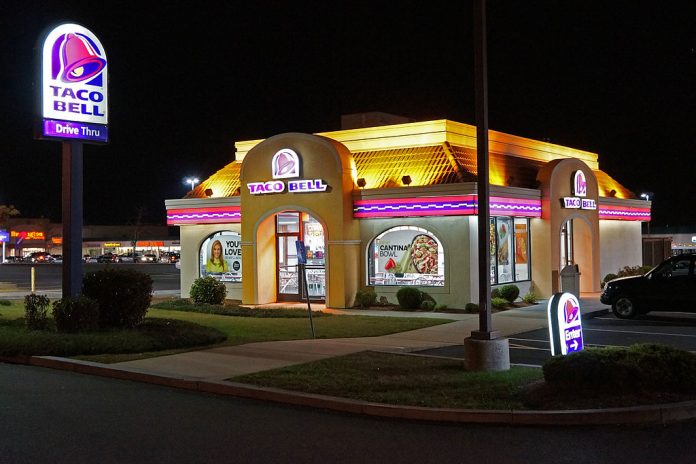Whether it’s a airy beach shack, cantina with adult playground or a downsized drive-thru, Taco Bell is on track to have 10,000 stores up and running by 2029 with an array of designs created to meet customers in all the many places they engage with the Mexican-American brand. The brand acknowledges that the past year has altered the way we interact with each other and restaurants dramatically, and that has triggered a new era of adaptability in all Taco Bell does, according to a press release on its store design approaches.
Six years ago, Taco Bell said it realized its customers wanted urban gathering places without drive-thrus, leading to the development of its cantinas. Then as COVID-19 pushed everyone to move toward more contactless experiences with QSRs, the brand released digital and drive-thru store enhancements.
It said the road ahead will «take modernization to new levels from coast to coast.»
«Prioritizing our development plans continues to be a major focus for 2021, especially as we look towards building our next thousand restaurants,» Mike Grams, Taco Bell’s president and global COO, said in the release. «Our restaurant portfolio continues to rapidly evolve, striking a crucial balance between being technology-forward and social-oriented. Even amid the challenging pandemic, we are continuing to grow due in large part to the strength in our franchise partnerships as well as the flexible formats we offer.»
With the brand’s array of store design approaches, along with the changing cultural landscape in the U.S., design hybridization has even begun within Taco Bell and its franchisees. Earlier this year, Taco Bell and franchisee Diversified Restaurant Group collaborated to open the first ever drive-thru cantina in Danville, California, merging proven cantina success with the prioritization of drive-thru service during the pandemic. The restaurant is the first of its kind with features such as an outdoor fire pit and game area, as well as full bar offerings for dine-in guests once it’s safe to do so.
«I’ve been in the real estate and development business for decades,» SG Ellison, president of Diversified Restaurant Group, said in the release. «The partnership we have with Taco Bell is unique — the brand empowers us franchisees with both autonomy and support, which has allowed my business to not just build traditional restaurants, but create destinations such as our flagship Taco Bell Cantina in Las Vegas, as well as our Cantinas in Pacifica and now Danville.»
Design diversification in digital, too
The brand will continue building destination restaurants, but will also simultaneously prioritize digital elements to maximize efficiency for on-the-go customers. One upcoming opening in the heart of Manhattan will be kiosk-focused for a completely digital, yet in-person experience.
Taco Bell will also continue rolling out its Go Mobile concept that began testing last year, which features minimalistic physical spaces and dual drive-thru lanes. Taco Bell said the national concept rollout has given its franchisees something to get excited about.
As President and COO of franchise K-Mac Enterprises, Tina Reagan has led the charge within the brand to remodel older Taco Bell restaurants, and has recently been focusing on Go Mobile.
«While new development is important, so is remodeling our existing restaurants to fit the needs of each trade area’s customers and surrounding community,» Reagan said in the release. «We are always looking to evolve to meet our guests needs, and transforming to be more digital-forward is no exception. In the last year, we’ve remodeled three restaurants into our Go Mobile format, and plan to both remodel and build over 30 additional Go Mobile restaurants by year end.»
The Go Mobile concept’s concierge service of team members, known as «bellhops,» is intended to improve drive-thru speeds with tablet ordering and curbside pickup. Taco Bell said customers can expect to see up to 1,000 bellhops working at its stores across the U.S. by the summer.
Another franchisee that is helping the brand evolve its store designs to meet changing customer is franchisee and Border Foods CEO Lee Engler, whom Taco Bell said is pushing the boundaries of what future restaurants will look and feel like. In addition to working with the brand, Engler and his team invited experts outside of the QSR industry to help collaborate on an industry-defying restaurant, set to be revealed in the coming months.
«As great as the drive-thru is, a fundamental flaw is bottleneck at the windows,» Engler said in the release, echoing a problem experienced throughout the QSR landscape. «Our team has set out to creatively solve for that like no one else has done before, and we’re thrilled by positive early responses to our one-of-a-kind concept coming to Brooklyn Park, Minnesota.»
With leading-edge offerings, Taco Bell’s new locations will join the ranks of other iconic Taco Bells, from the wedding chapel in Las Vegas to the beachside spot in Pacifica. With 2021 development growth anticipated to outpace that of 2020, Taco Bell said it’s worked to build expansion plans that feature long-term flexibility, franchisee insights and innovation in everything from its Vegas wedding chapel to its beachside store in Pacifica, California. Since adaptability in all things has been repeatedly identified as one of the primary post-COVID-19 QSR keys to success, the Irvine, California-based brand’s efforts to build it into its store offerings seem to have it headed in the right direction.









